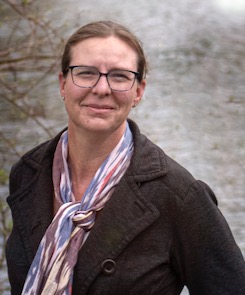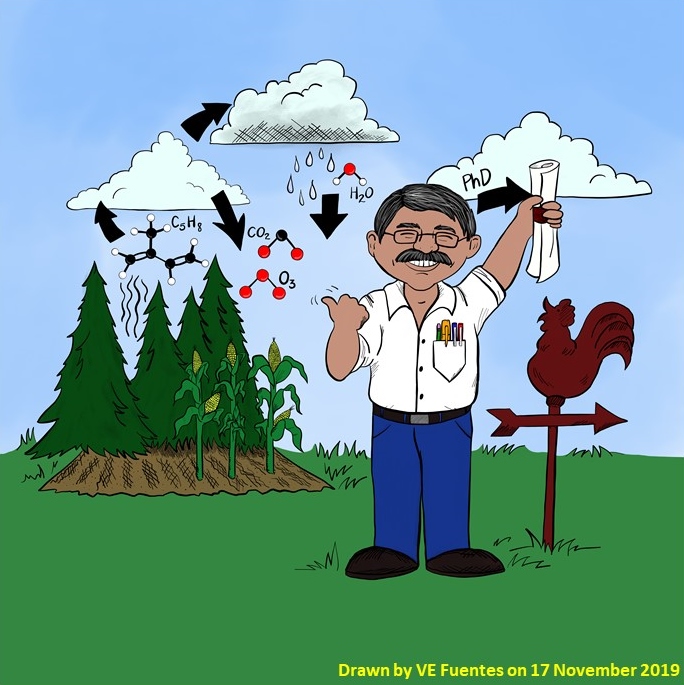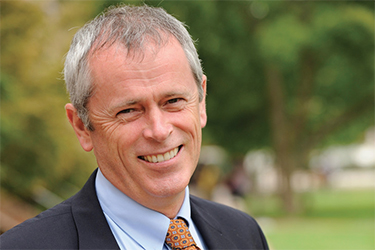Dr. Lara Fowler, Director of Penn State Sustainability and Chief Sustainability Officer of Penn State
Dr. Lara Fowler is an attorney, professor, and mediator who focuses on environmental, energy, and natural resource law, with a specific focus on water-related issues. In May 2023, Fowler was named as the Chief Sustainability Officer of Penn State and Director of Penn State Sustainability (formerly known as the Sustainability Institute) after serving in an interim status for both roles since July of 2022. She joined Penn State in 2012, holding joint appointments between Penn State Law and the Penn State Institutes of Energy and the Environment where she has been working questions related to water, the Chesapeake Bay, and energy. Prior to joining Penn State, she was an attorney at Gordon Thomas Honeywell LLP in Seattle, Washington, where she focused on mediation and dispute resolution of complex natural resource issues, as well as representing clients facing regulatory hurdles in the environmental and energy fields. She has worked on issues such as who is entitled to store groundwater in the greater Los Angeles area, flooding issues in the Chehalis Basin, Washington State’s second-largest river basin, and energy issues in the Pacific Northwest. Before pursuing a legal career, she was a senior water resources coordinator with the Oregon Water Resources Department.
We like to start these interviews with a similar question for all our subjects. What does sustainability mean to you?
Sustainability? That’s a good question. I think about sustainability as how we help both people and the planet. But, it’s also what is healthy and safe for the environment and that we’re living more in harmony with the Earth, rather than extracting and degrading resources as we go along. And again, not only for current generations; future generations are something really important to me.
Now, the continuation of usage is still very important. Usage is a bit of a strong word to describe this, but I recognize that most of us know that humans extract resources to live and function. Sustainability is about asking the question, ‘How do we not destroy our home while we are at it?’
You said that “usage” is too strong of a word in this context. What would be an appropriate choice of word to put here?
With the question of usage, I often think about the management of resources. I live in the world of water, there’s really no water that isn’t “recycled” one way or another. If you think about it, we’re all part of a cycle with water that was once used by the dinosaurs. Today, we are seeing changes to the water cycle: climate change is water change. We are also seeing degradation in water quality, which has a big impact.
Today, we have more crisis events like flooding or droughts occurring back to back. In a healthy system, things like floods and droughts occur sporadically, but now we’re stacking the deck and seeing more of both – regularly. Changes in land use also increase these impacts. So, how do we manage those extremes and our most precious resource – water, when the water system is fundamentally shifting very quickly?
A good friend of mine lives in Vermont, which recently faced recent severe flooding. They have so much water that you think; ok, well what’s the problem with more water? You may have a lot of water, but this water isn’t safe to drink. Flood water is dirty; it has picked up human waste, gasoline, chemicals, you name it as it moves throughout the community. But if your sanitation systems have been destroyed in the flood, how do you manage that? It becomes a very difficult task and a question of balance, both using resources and managing them. So, the long answer is that ‘management’ is a word that could replace ‘usage’.
Speaking of managing our resources appropriately, what does a sustainable society look like to you, in terms of water management, and how do you maintain it?
In my case, in terms of water again, how are we thoughtful and mindful of what we use, and then how do we return the water into the water cycle? I grew up in the Pacific Northwest and if we look at the early history of the United States–more accurately; the early white history of the United States–it was thought that there are simply more fish in this region than we could ever possibly impact, there is more water than we can do anything to, and water left flowing into the ocean is a waste and we must use it up. Now, fast forward 150 to 200 years into our current era and we realize that with this mentality we’re actually exterminating countless species in the region. So, how do we shift and learn to cohabit with nature?
Now, what I love is that there’s a lot of work in Pennsylvania being put into restoring ecosystems as people have realized that we’re very dependent on what our natural world provides for us. We as humans have proven very adept at destroying the natural world, but we’ve also proved that we’re very adept at restoring the natural world when we put our minds to it. For example, in the 1970s, the Bald Eagle – our national bird, had almost gone extinct and after efforts and attempts to restore their populations, we now have a rejuvenated population. So, if we put our minds to it we can figure out ways to be in this world without destroying it and be able to bring it back.
Another element of living with the natural world is thinking about how we use space. My home is 102 years old and will far outlive me; I think about my role as a trustee of the house rather than an owner. Similarly, we have to keep space for the natural world to exist and function while still cohabitating with it. In parts of the world where people have helped natural ecosystems return or “rewild,” we’ve seen the natural world recover much more quickly than we might expect it to.
Do you think the reuse of the same area for communities will help with the preservation of natural space?
Sure, I’ve done a lot of reading about what makes people happy and talked to colleagues about this as well. Having more stuff does not make people happy. Having connections, feeling like you’re contributing, feeling that you belong somewhere, and having friends, makes you happy.
One of my favorite authors Rebecca Soule wrote a fantastic book called A Paradise Built in Hell. Which has documented the mutual aid societies that are created after a natural disaster. It said that after the 1906 San Francisco Earthquake, the people came together and let down normal individualistic barriers between one another and allowed each other to help. They began living in community with each other. That sense of community is what keeps people together.
In the State of Washington, at my last job, there had been a few years of consecutive flooding in the larger river basin, and there had been a ton of finger-pointing about who is responsible for what. Until the governor at the time said that “I can impose a top-down solution. But, no one will like it. So, I will turn over the responsibility to local communities and they can find local solutions to the problems of their region’s flooding and how they’d like to address it.” It’s taken a huge amount of work and was eventually a success. These people now had local solutions and a much tighter-knit community as a result of being invited to participate in creating solutions for themselves and their neighbors.
Now to shift topics a little bit, you have a formal education in Asian Studies and Native American water rights. Do you think that being educated on a variety of cultures helps contribute to your professional success?
I had not intended to fall into the path of law or sustainability when I entered my college years. But having already studied Japanese in high school, it was relatively straightforward to pursue a degree in Asian Studies while also studying in Japan for a time. At the same time, I took a geography class on water management and learned about Native American rights to water. I then applied and received a research grant to pursue this topic further. While an undergraduate student, I attended a conference and met an attorney representing the Confederated Tribes of the Warm Springs Reservation (Oregon). The Confederated Tribes were negotiating with the State of Oregon and the federal government for their water rights. This introduction launched me into 3+ years of attending negotiation sessions and creating a program of study in water resources. I spent my senior year in college writing a thesis on this particular negotiation.
Both sets of experiences—both my formal major and my self-created program of study—helped reinforce the need for an open mind and let me come from a place of humility and curiosity. This curiosity also led me to eventually become a facilitator and a mediator, where I have the privilege of listening to multiple people tell their “story,” and then working with them to find potential solutions that might be bogged down in breakdowns of communication. That is my job, to listen.
So, in the world of sustainability, I think it is very helpful to have a broader understanding of various cultures to enable better listening to people’s truths and to be able to hear where they are coming from.
Can you elaborate more on your role as a mediator? Especially in the area of natural resources.
My job is to listen. Not only to think about and listen to the people who are involved, but also to be able to give a voice to something or someone that might not have one. For example, who speaks for the rivers or fish populations? It’s very much a constant gray area of work and managing sliding scales of who gets what and for how long and for what purpose.
For example, in the country of Colombia, a nation that has been plagued by incredible violence for decades, they are attempting to reverse the devastation they’ve experienced and have peace. But the peace agreement is fragile, especially if you don’t find ways to manage it. And people are going; “Oh, it’s safe to go to Columbia and visit all the national parks.” So, there’s an influx of tourism. Which is great for the economy. However, the surge of people is adversely affecting wildlife. That’s an example of a series of sliding scales that need to be managed. I’ve worked with a number of Penn State students from Colombia who are very focused on how they might help their country navigate dynamics like this.
Is there anything you’d like to say to a potential or current law student about the specialization of resource management?
There are far more opportunities than you might ever be able to imagine; following your passion can lead you to unexpected places. For example, after working on water policy for a few years, I attended law school to become a mediator, not a lawyer. I was able to parlay this educational experience into becoming a water mediator right out of law school, working for a private law firm in Washington State. My projects included challenging situations like who gets to store groundwater in Los Angeles and water allocation between northern and southern California. These are big questions. But, this all began as a curiosity when I started working in water. I had no idea that you could have a career like the one that I have today. Now, I have a colleague who publishes a listerv of hundreds of water-related jobs a week. There are ample opportunities to pursue careers in this field.
If you think your curiosity and passion coexist within the field of law, there are so many uses for a law degree that are absolutely brilliant. I had no idea that you could even do that until I worked with mediators and was engaging with lawyers in different spaces. And these spaces are a lot bigger and more detailed than you would think. They are complex and crazy, but also beautiful and interesting. Again, this can lead to the question of what kind of future we can and want to build together and how our individual passions will contribute to shaping the world we want to see.
Now you have gone to Sweden to research water quality, cooperation, and human management. Can you tell me a little about the research involved?
While I was in Sweden, I worked on comparisons between the Baltic and the Chesapeake. Both regions have similarities, so it was interesting to see the differences between the European approach to handling the Baltic and the U.S. approach to handling the Chesapeake. For example, colleagues in Denmark were amazed that cow manure lagoones weren’t covered as a matter of course. While this type of approach is different, the overall challenge of managing dispersed or non-point sources of pollution are similar.
Is there anything that I have not mentioned that you would like to note on the topic of water management?
Right now, we are working in a world of climate extremes and unpredictability. And it’s going to take some thought and mindfulness to manage these systems; both man-made and natural, for folks in agriculture and stream habitat and wildlife.
One of my best moments this spring was going out with a group of students on a warm spring night when it had rained and we were out looking at all the newts and frogs near Shaver’s Creek. I wish we recorded the excitement everyone had about what they were finding, about the incredibly biodiverse world we all live in and need to protect. How do we inspire more of that? In part, we need to ensure the conservation of clean water and manage water quality in that regard. But, we also need to have joy and enthusiasm. One of my favorite things about my role now is that – despite so many scary things happening and the fact that it’s easy to get overwhelmed— there are so many good things happening. So, I get to be the biggest cheerleader and help bring people along as we work together to foster a world with more joy, with more resilience. It’s hard work, but it’s possible to build a more sustainable world, for current and future generations.





